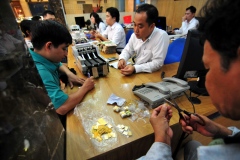Gold owners concerned as new restrictions loom large
The bill, seen as a guideline for the gold bullion trading market, rules that only one-tael SJC gold bullion of 99.99 per cent purity is eligible for transactions. Last year SJC was selected as a state gold brand name under the SBV’s bid to better control the market.
Saigon Jewelry Co currently produces as many as seven different types of SJC gold bars, depending on their weights: 1/20 tael, 1/10 tael, 1/5 tael, 1/2 tael, 1 tael, 10 tael, and 1 kilogram. All of them have the same ask and bid prices, according to prices listed by the company.
But gold holders say they are afraid of being forced to sell their precious metal at low prices due to their light weights.
“I could only afford to buy gold bullion of 1/10 and 1/5 tael, so I’m wondering if I can still sell them at the right prices,” said Huong, a Phu Nhuan District resident.
Owners say small amounts of gold bullion have higher buying prices, but lower selling prices than the one-tael product.
“It’s because it’s costlier to produce the small-weight gold bars,” explained Tran Thanh Hai, CEO of the Vietnam Gold Business.
The central bank intended to make one-tael gold bullion the only eligible product for transaction because it is the most common type of gold bullion on the market, Hai added.
“But it turns out that this will affect the interests of many gold owners,” he said.
Businesses worried, too
While the central bank claims that all of the new policies applied to the gold market are intended to stabilize gold prices and reduce the gap between domestic and international gold prices, businesses still maintain their concerns.
The central bank has stipulated that any transaction between it and the gold businesses will last two days, a requirement traders say may negatively impact their operation.
“Gold prices constantly fluctuate every minute, but we have to wait two days for the transaction to be completed,” a CEO of a gold company said, asking not to be named.
“So we have to contact the central bank two days prior to the transaction; and the gap between local and international gold prices will never be narrowed,” he added.
The draft guideline also requires that businesses “establish a trading relationship with the central bank” after obtaining the license to trade the precious metal.
This is a huge disadvantage as businesses have to seek permission to trade gold bars twice, they said.
Too much regulation
Dinh Nho Bang, general secretary cum deputy chairman of the Vietnam Gold Business Association, said gold bullion trading is a transaction between gold traders and members of the public, but the central bank has intervened too much.
“There is no national standard for gold in other nations, and the central banks there do not directly trade the precious metal,” he said.
Paradoxically, Vietnam is importing international-standard raw gold material and turning it into SJC gold bullion, which is only valuable domestically. When exported, SJC gold is only seen as raw material.
“Gold prices are determined by the market, and if the central bank wants to determine prices, they should clarify whether it is feasible and how they will realize it,” Bang concluded.
| SJC gold opened today at VND45.45 million a tael, VND150,000 a tael higher than Monday closing. But the rate is still VMD200,000 a tael lower than before the Lunar New Year. International gold price meanwhile stood at $1,613.5 an oz, or VND40.55 million a tael, sending the gap between domestic and international prices to as much as VND4.9 million a tael. |
What the stars mean:
★ Poor ★ ★ Promising ★★★ Good ★★★★ Very good ★★★★★ Exceptional
Related Contents
Latest News
More News
- Global partnerships key to Vietnam’s IFC development (December 26, 2025 | 16:18)
- Vingroup pulls out of bid to invest in North-South high-speed railway (December 26, 2025 | 11:42)
- Strengthening supply chains through trade promotions and customs reform (December 24, 2025 | 14:00)
- PM orders investment model for North–South high-speed rail (December 22, 2025 | 17:43)
- LS Eco Energy to invest in Vietnam rare earth sector (December 22, 2025 | 17:31)
- Government moves to establish International Financial Centre (December 21, 2025 | 21:00)
- Vietnam's IFC to target global investment flows (December 21, 2025 | 18:00)
- Two national hospitals expand capacity with new facilities (December 20, 2025 | 09:00)
- Ha Tinh breaks ground on major Vingroup industrial and energy projects (December 19, 2025 | 18:24)
- EVN launches major power infrastructure projects nationwide (December 19, 2025 | 18:17)


 Tag:
Tag:





















 Mobile Version
Mobile Version